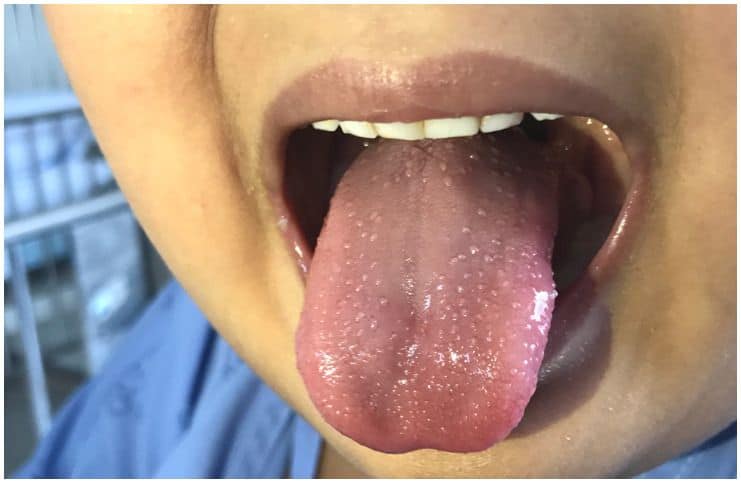Kawasaki Disease vs Scarlet Fever – detailed comparison:
Kawasaki Disease
Kawasaki disease, also referred to as mucocutaneous lymph node syndrome, is an illness that causes inflammation in the veins, arteries, and capillaries.
Also, it affects the skin, lymph nodes, and the mucous membranes in the nose, mouth, and throat.
An estimated 75% of cases are children under the age of 5 (especially those of Asian descent), with most of the children being less than 2 years old.
In the US, 19 children in every 100,000 are admitted to the hospital with KD per year. In addition, KD is the leading cause of acquired heart disease in young children.
It was first described in 1967 by Dr. Tomisaku Kawasaki, a Japanese pediatrician.
Symptoms
The first phase (which can last for up to 14 days) commonly involves a fever that lasts for at least 5 days.
Other symptoms include:
- stomach trouble, with vomiting and diarrhea;
- rash and/or peeling skin, commonly in the genital or groin area and between the legs and chest, and later on the toes and fingers;
- joint pain;
- redness and swelling in the hands;
- bright red “strawberry tongue;”
- irritated inner mouth, throat, and lips;
- enlarged glands, particularly in the neck;
- redness in the eyes.
Note – KD symptoms commonly resolve within 30 to 60 days, however, this disease should be considered a “lifelong disease” since monitoring for late-onset heart artery changes is required.
Complications
While most patients completely recover, around 5 percent experience complications with their heart.
Causes
Although the cause of KD is unknown, it is widely thought to be due to an abnormal immune response to infection or an infection. KD doesn’t seem to be hereditary, nor contagious.
Risk Factors
Most cases occur in children younger than 5 years old. KD is more likely to affect boys than girls. Also, the disease occurs most often in children of Asian and Pacific Island descent.
Diagnosis
To diagnose it, healthcare providers look at the symptoms and signs. In addition, they may use an echocardiogram (uses high-frequency sound waves) or other tests.
Treatment
If left untreated, about 20 percent of children with KD will suffer damage to their heart.
The usually recommended therapy includes admission to a hospital and administration of high-dose aspirin and intravenous immunoglobulin (a medicine prepared from human plasma) until the patient’s fever resolves.
Then, the treatment is continued with low-dose aspirin (acetylsalicylic acid) for 6 to 8 weeks until a normal echocardiogram has been obtained.
Scarlet Fever
It is a bacterial illness that mainly affects children (in particular those between the ages of 2 and 8) and is caused by Streptococcus pyogenes bacteria.
SF is more common in temperate areas than in warmer tropical areas. In 2016, there were 33 cases per 100,000 people in the United Kingdom.
Symptoms
SF usually starts with the following symptoms:
- fever over 101°F;
- red and sore throat;
- enlarged tonsils with painful swallowing and a white coating;
- swollen lymph nodes on the neck;
- headache.
After 12 to 48 hours, a red, pinhead rash develops, usually first appearing on the stomach and chest, and rapidly spreading to other parts of the body. It clears in about one week.
READ MORE: Graves Disease vs Hashimoto’s Thyroiditis
Complications
Most cases of SF have no complications. Sometimes, one of the following complications occurs, and it may include:
- rheumatic fever (an inflammatory disease that can involve the joints
, skin, heart, and brain); - ear infection;
- pneumonia (a lung infection that can be mild or severe);
- otitis media (an inflammation of the middle ear);
- kidney inflammation;
- sinusitis;
- throat abscess.
Note – complications tend to happen only if treatment is unsuccessful or if SF has not been treated.
Causes
It is caused by an infection with bacteria called A streptococcus. This is the same bacteria that causes strep throat.
You can contract SF by touching the skin of an infected person, breathing in bacteria from airborne droplets, or sharing contaminated baths, towels, clothes, or bed linen.
It can take up to a week for the symptoms to appear after being infected with the bacterium.
READ MORE: Roseola vs Fifth Disease
Risk Factors
Exposure to others with illness and age are the known risk factors for getting the infection.
Diagnosis
To confirm whether a patient has SF, healthcare professionals typically order a rapid strep test or throat culture to check for the bacteria.
Treatment
If your child has SF, your healthcare professional will prescribe an antibiotic. Liquid antibiotics, like – amoxicillin or penicillin, are commonly used to treat children.
Tip – try to avoid contact with children that are known to have SF until they have been on medicines for one day.
READ MORE: Dysrhythmia vs Arrhythmia
Kawasaki Disease vs Scarlet Fever – Differences
Kawasaki disease causes inflammation in the walls of medium-sized arteries throughout the human body. It is most common among children of Japanese and Korean descent, however, the disease can affect all ethnic groups. It is the leading cause of acquired heart disease in children under 5 years of age.
Scarlet fever, also known as scarlatina, is an infectious bacterial illness, that commonly involves fever, a sore throat, and a rash. It can affect people of all ages, however, it is most often seen in children.
READ THIS NEXT: Peyronie’s Disease vs. Normal Curvature
References https://www.ncbi.nlm.nih.gov/pmc/articles/PMC4828822/ https://www.sciencedirect.com/topics/medicine-and-dentistry/scarlet-fever https://www.ncbi.nlm.nih.gov/pmc/articles/PMC4696947/
